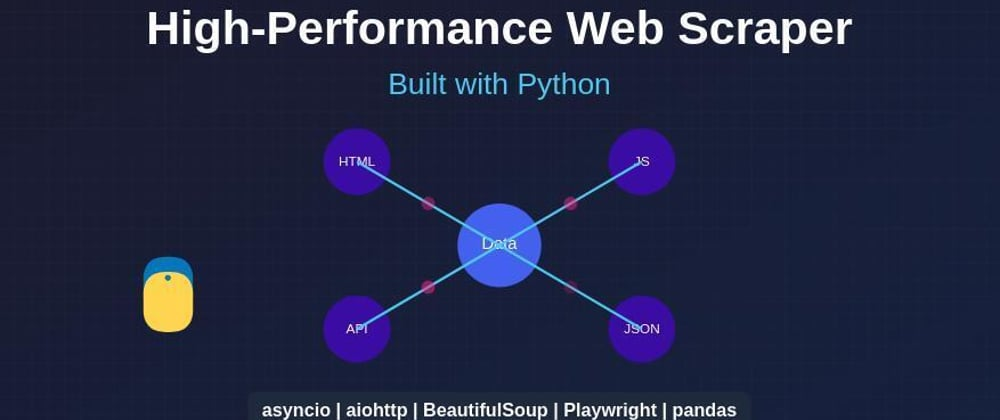引言
本文探讨了一种高性能网页爬虫的架构和实现,该爬虫旨在从电子商务平台提取产品数据。该爬虫使用多个Python库和技术,以高效处理数千个产品,同时保持对常见爬取挑战的韧性。
技术架构
该爬虫建立在完全异步的基础上,使用Python的 asyncio 生态系统,包含以下关键组件:
- 网络层:
aiohttp用于异步HTTP请求,支持连接池 - DOM处理:
BeautifulSoup4用于HTML解析 - 动态内容:
Playwright用于提取JavaScript渲染的内容 - 数据处理:
pandas用于数据操作和导出
实现亮点
并发管理
该爬虫实现了一个工作池模式,具有可配置的并发限制:
# 并发设置
self.max_workers = int(os.getenv('MAX_WORKERS'))
self.max_connections = int(os.getenv('MAX_CONNECTIONS'))
# TCP 连接池
connector = aiohttp.TCPConnector(
limit=self.max_connections,
resolver=resolver # 自定义 DNS 解析器
)
这可以防止对目标服务器造成过大的压力,同时最大化吞吐量。弹性网络请求
网络层实现了复杂的重试逻辑,并采用指数退避策略:
async def fetch_url(self, session, url):
retries = 0
while retries < self.max_retries:
try:
headers = {
'User-Agent': self.user_agent.random,
# 为了简洁省略了其他头部信息
}
async with session.get(url, headers=headers, timeout=self.request_timeout) as response:
if response.status == 200:
return await response.read()
elif response.status == 429:
# 速率限制处理
retry_after = int(response.headers.get('Retry-After',
self.retry_backoff ** (retries + 2)))
await asyncio.sleep(retry_after)
# 使用指数退避重试
retries += 1
wait_time = self.retry_backoff ** (retries + 1)
await asyncio.sleep(wait_time)
except (asyncio.TimeoutError, aiohttp.ClientError) as e:
logger.warning(f"网络错误: {e}")
retries += 1
混合内容提取该爬虫采用两阶段提取方法:
- 静态HTML解析:使用BeautifulSoup提取现成的内容
- 动态内容提取: 使用 Playwright 处理 JavaScript 渲染的元素
async def fetch_product(self, session, url, page):
# 静态内容提取
with concurrent.futures.ThreadPoolExecutor() as executor:
loop = asyncio.get_event_loop()
product = await loop.run_in_executor(
executor,
partial(self.scrape_product_html, content, url)
)
# 动态内容提取
image_url, description = await self.scrape_dynamic_content_playwright(page, url)
product.image_url = image_url
product.description = description
这种方法在速度和完整性之间进行了优化。DNS 弹性
爬虫实现了 DNS 回退机制,以处理潜在的 DNS 解析问题:
try:
import aiodns
resolver = aiohttp.AsyncResolver(nameservers=["8.8.8.8", "1.1.1.1"])
except ImportError:
logger.warning("未找到 aiodns 库。将回退到默认解析器。")
resolver = None
数据处理管道
爬虫实现了一个线程安全的队列来处理抓取的数据:
# 结果的线程安全队列
self.results_queue = queue.Queue()
# 数据处理
def save_results_from_queue(self):
products = []
while not self.results_queue.empty():
try:
products.append(self.results_queue.get_nowait())
except queue.Empty:
break
if products:
df = pd.DataFrame(products)
# 以正确的编码和转义保存为CSV文件
df.to_csv(
filename,
index=False,
encoding='utf-8-sig',
escapechar='\\',
quoting=csv.QUOTE_ALL
)
性能优化
采用多种技术来最大化吞吐量:
- 批处理:产品以可配置的批次进行处理
- 随机延迟:请求之间的随机延迟防止被检测
- 连接池:TCP连接重用减少开销
- 线程池执行器:将CPU密集型任务卸载,以防阻塞事件循环
- 抽样:对于大型数据集,使用统计抽样来估算总计数
错误处理与可靠性
抓取程序实现了全面的错误处理:
try:
# 抓取逻辑
except Exception as e:
logger.error(f"在 scrape_all_products 中发生错误: {e}")
# 在退出之前保存队列中的任何结果
self.save_results_from_queue()
raise
这确保了即使爬虫崩溃,部分结果也会被保存。
结论
这里概述的架构展示了如何构建一个高性能的网络爬虫,能够在速度、可靠性和对目标服务器的礼貌之间取得平衡。通过利用异步编程、连接池和混合内容提取技术,爬虫能够高效处理数千个产品,同时保持对常见爬取挑战的韧性。
关键要点:
- 异步编程对于高性能网络爬虫至关重要
- 混合静态/动态提取最大化数据完整性
- 适当的错误处理和韧性机制对于生产环境至关重要
- 可配置参数允许根据目标网站特性进行微调


